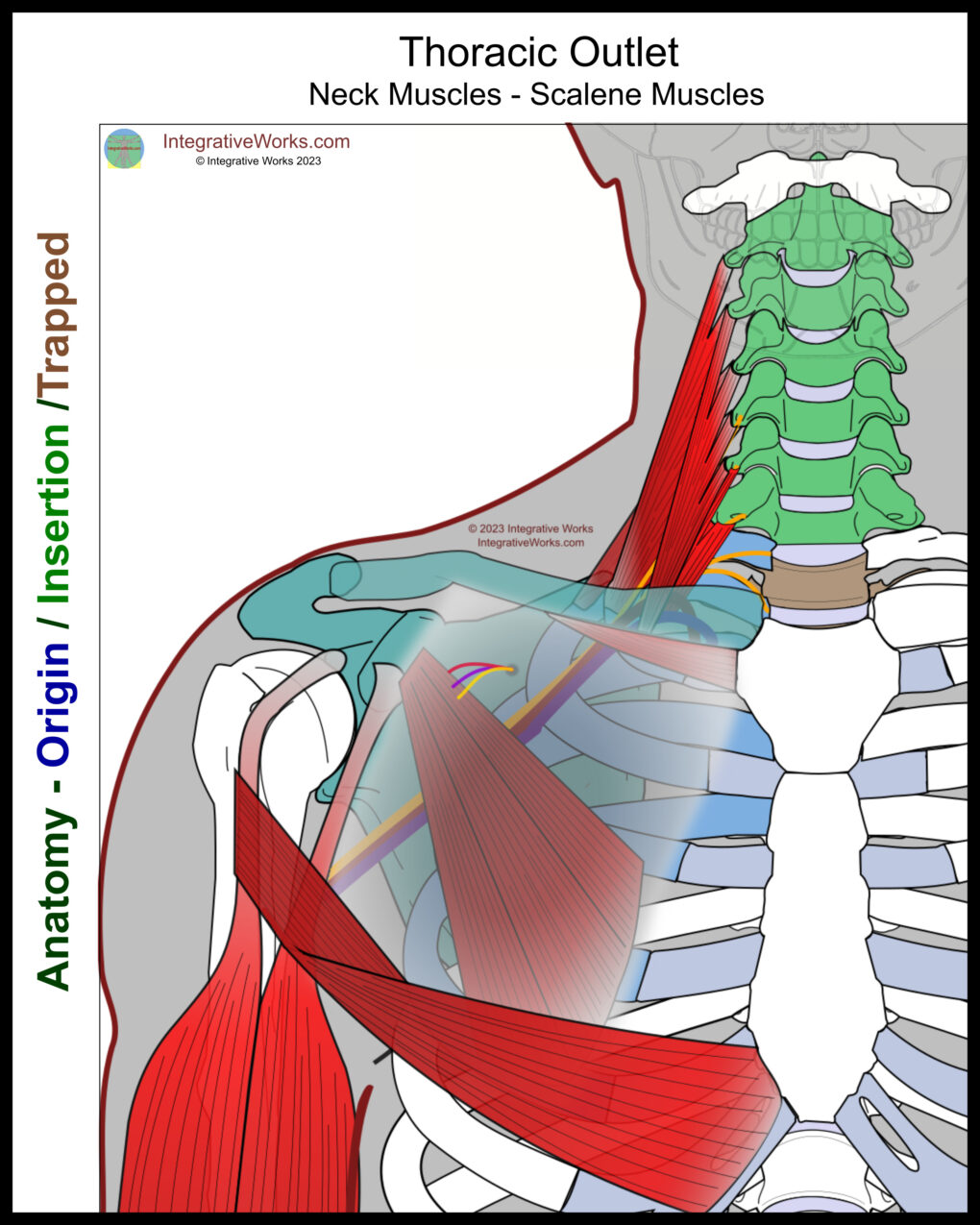Thoracic Outlet Syndrome: Pain Patterns, Causes, Self-Care


Overview
Thoracic Outlet Syndrome (TOS) is a group of related symptoms indicating a neurovascular bundle restriction that supplies the upper extremity. TOS is not a precise diagnosis. Like other syndromes, such as Chronic Fatigue Syndrome or Piriformis Syndrome, it is a collection of related symptoms.
Neurovascular Restrictions
The term “thoracic outlet syndrome” implies dysfunction occurs where the nerves and vascular structures pass over the first rib. Despite that, “Thoracic Outlet Syndrome” usually refers to structural problems impacting the neurovascular bundle from the first rib to the axilla. These problems may include restrictions in the brachial plexus, subclavian artery, subclavian vein, and subclavian lymph trunk.
The first section of this document reviews the boney structures that are most directly involved. The remaining sections examine the other involved structures, building from posterior to anterior.
Casually Speaking
Casually, people use “Thoracic Outlet Syndrome” when talking about pain and dysfunction in the upper extremity. This document focuses on the structures that create restriction and dysfunction in the neurovascular structures of the thoracic outlet.
Interestingly, the muscles discussed here also have trigger point patterns that refer to the arm. In addition, several other muscles, not in the thoracic outlet structure, refer from the torso into the arm. Look at the “Torso into Arm” post for those muscles and their trigger point patterns.
Musculoskeletal Anatomy
Trigger Points and Anomalies Make This More Complicated
The thoracic outlet structures are complex. To make it more complicated, muscles like scalenes, pec minor, and levator scapula have statistically significant variations. Scalenes are quite variable in size, attachments, and, even, number of muscles. The pectoralis minor is variable in its attachment on ribs. Levator scapula sometimes attaches to a rib. Also, posture, activity, and weight all add to how this area works.
Many muscles that in the neck, upper back, and chest refer to the upper torso, shoulder, and down the arm. These patterns look like thoracic outlet problems. infraspinatus, pectoralis major, and serratus posterior superior create these kinds of patterns.
Posts Related to Thoracic Outlet Syndrome
These posts are directly related to the anatomy, pain patterns, self-care, and treatment of Thoracic Outlet Syndrome.
Pain Along the Biceps, Maybe Collar Bone & Forearm
Pain in the Front of Shoulder When Lifting Arm
Pain in the Torso and Arm: Signs, Pain Patterns, Self-care, Therapy Notes…
Pain in the upper back, index finger, and thumb
Pectoralis Minor – Massage Therapy Notes
Pectoralis Minor – Functional Anatomy
Scalene Muscles – Functional Anatomy
Scalenes – Massage Therapy Notes
Scalenes Supine – Neuromuscular Massage Protocol
Self Care – Breathing exercise for upper back pain
Self Care – Forward-Head Posture
Self Care – Pain in the Biceps, Maybe Collarbone, Forearm
Self Care – Pain in the Front of Shoulder When Lifting Arm
Self Care – Scalene Pain of Upper Back, Arm & Hand
Self Care – Seated Stretches for Stiff, Swollen Hands
Self Care – Tuck Tilt Turn Lift to Correct Forward-Head Posture
Stiff, Swollen Hands in the Morning
Stretching for scalene muscles
Subclavius – Massage Therapy Notes
Subclavius- Functional Anatomy
Thoracic Outlet – Functional Anatomy
Trigger Point Patterns That Refer Into
the Torso, Shoulder and Down the Arm
These patterns look like TOS because they refer into the torso, shoulder, and down the arm. Some of these patterns come from TOS muscles and others do not.
Support Integrative Works to
stay independent
and produce great content.
You can subscribe to our community on Patreon. You will get links to free content and access to exclusive content not seen on this site. In addition, we will be posting anatomy illustrations, treatment notes, and sections from our manuals not found on this site. Thank you so much for being so supportive.
Cranio Cradle Cup
This mug has classic, colorful illustrations of the craniosacral system and vault hold #3. It makes a great gift and conversation piece.
Tony Preston has a practice in Atlanta, Georgia, where he sees clients. He has written materials and instructed classes since the mid-90s. This includes anatomy, trigger points, cranial, and neuromuscular.
Question? Comment? Typo?
integrativeworks@gmail.com
Follow us on Instagram
*This site is undergoing significant changes. We are reformatting and expanding the posts to make them easier to read. The result will also be more accessible and include more patterns with better self-care. Meanwhile, there may be formatting, content presentation, and readability inconsistencies. Until we get older posts updated, please excuse our mess.